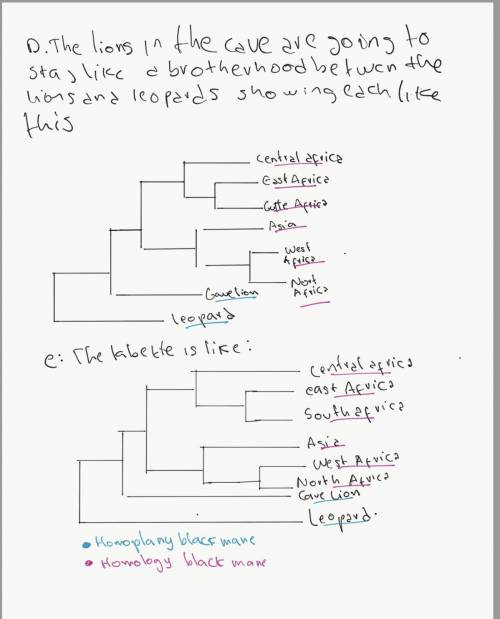
A study published earlier this year used genomic data to construct a phylogenetic tree of lions. All of the lions on the tips of the tree are extant (living).
A. This study discredits the idea that there are two distinct geographic variants of lions: one with lion populations from Central Africa, Asia, and West Africa and the second with lion populations from South Africa and East Africa. Use the tree to defend why these two groups of lions are unlikely.
B. North African lions are critically endangered and some populations have gone locally extinct. Some scientists claim we can "use the most closely related Asian Lions to restore the population." Using what is wrong with this statement, defend which lineage would be better for the purpose of restoring North African lions.
C. The authors of the study measured the amount of heterozygosity in each population of lions and found more
homozygosity (less heterozygosity) in the monophyletic group of lions in Asia, West Africa, and North Africa (compared to the monophyletic group of Central, East, and South Africa).
• Use this information to infer the size of the isolated populations when divergence occurred. Explain your
reasoning.
• Of the populations in Asia, West Africa, and North Africa, which population likely has the least heterozygosity?
Explain your reasoning.
D. The study used the now extinct Cave Lions as sister taxa to modern lions and Leopards as an outgroup to root their tree. Use SketchPad and the template provided named "SketchPadExam3OfficialTemplate. sketchpad" to add "Cave Lion" and "Leopard" to the tree.
E. South African lions and North African lions have black colored manes (compared to the others that are lighter). Use the same tree on the SketchPad template (on which you drew cave lions and leopards) to mark the origin of the black manes if this trait is homologous: Label it "Homology". Mark the origin of black manes on the tree under the hypothesis that it evolved independently: Label it "Homoplasy"
F. Using on the information you drew on the tree in part e, which hypothesis do the data support?
G. State whether each of the following statements is true or false.
A. The monophyletic group of Asian lions has undergone less evolution than the monophyletic group including West African and North African lions.
B. Asian lions have a very small mane. Reduced manes are a derived trait.

Answers: 1


Another question on Biology


Biology, 21.06.2019 19:40
What does it mean for a cell membrane to be selectively permable
Answers: 1

Biology, 21.06.2019 22:40
Environmental differences within ecosystems are generally caused by
Answers: 1

Biology, 21.06.2019 23:30
Which of the following would be an important part of a multi-step plan to restore the stability of the red-cockaded woodpecker's ecosystem?
Answers: 1
You know the right answer?
A study published earlier this year used genomic data to construct a phylogenetic tree of lions. All...
Questions


Mathematics, 05.03.2022 02:50

Biology, 05.03.2022 02:50



Chemistry, 05.03.2022 02:50





Chemistry, 05.03.2022 02:50


Mathematics, 05.03.2022 02:50


English, 05.03.2022 03:00

Social Studies, 05.03.2022 03:00


English, 05.03.2022 03:00

Mathematics, 05.03.2022 03:00

English, 05.03.2022 03:00




